Translating Your Automobile'S Alert Lighting: Their Real Effects
Translating Your Automobile'S Alert Lighting: Their Real Effects
Blog Article
Web Content Writer-Lauritsen Gilbert
When you lag the wheel, those radiant caution lights on your dashboard can be a little bit difficult. Do you understand what they're attempting to tell you about your auto's health and wellness? Understanding the importance of these lights is vital for your safety and the long life of your vehicle. So, the following time one of those lights appears, wouldn't you intend to analyze its message properly and take the necessary actions to address it?
Common Warning Lights and Interpretations
Identify common caution lights in your automobile and recognize their significances to ensure safe driving.
One of the most normal caution lights include the check engine light, which signals problems with the engine or emissions system. If this light comes on, it's crucial to have your vehicle examined without delay.
The oil pressure warning light indicates reduced oil pressure, requiring immediate attention to prevent engine damage.
A flashing battery light might suggest a defective charging system, possibly leaving you stranded otherwise addressed.
The tire stress tracking system (TPMS) light notifies you to reduced tire pressure, affecting lorry stability and fuel performance. Overlooking this can lead to harmful driving problems.
The ABS light suggests a problem with the anti-lock braking system, endangering your capability to stop rapidly in emergency situations.
Finally, the coolant temperature alerting light warns of engine overheating, which can cause extreme damage otherwise solved swiftly.
Understanding https://brakesandrotors95172.tokka-blog.com/30500512/vehicle-repair-service-s-future-landscape-significant-patterns-to-observe-in-the-upcoming-years will certainly aid you attend to problems quickly and preserve secure driving problems.
Importance of Prompt Attention
Recognizing the typical warning lights in your auto is just the first step; the importance of promptly dealing with these warnings can't be highlighted enough to ensure your safety on the road.
When a warning light brightens on your dashboard, it's your automobile's means of interacting a possible concern that requires interest. Disregarding these cautions can bring about more extreme issues down the road, jeopardizing your security and potentially costing you a lot more in repairs.
Prompt attention to warning lights can protect against breakdowns and mishaps. For example, a blinking check engine light could indicate a misfire that, if left ignored, could cause damages to the catalytic converter. Addressing this immediately can save you from a pricey repair.
In a similar way, a brake system alerting light may indicate low brake fluid or used brake pads, critical parts for your safety and security when driving.
DIY Troubleshooting Tips
If you notice a warning light on your control panel, there are a few DIY repairing ideas you can attempt prior to looking for expert assistance.
https://brakerepair95062.wssblogs.com/30312305/a-guide-to-the-leading-10-factors-to-consider-for-finding-the-best-automobile-repair-shop-neighboring is to consult your auto's handbook to understand what the specific caution light suggests. In some cases the issue can be as basic as a loose gas cap triggering the check engine light. Tightening the gas cap may solve the trouble.
boat detailing near me is a low battery, which can cause different alerting lights. Checking https://collisionweek.com/2022/06/14/state-farm-testing-expanded-non-oem-collision-repair-parts-use-oklahoma-texas/ for deterioration and guaranteeing they're safe and secure might take care of the problem.
If a warning light continues, you can attempt resetting it by separating the car's battery for a few minutes and after that reconnecting it. Furthermore, examining your car's liquid degrees, such as oil, coolant, and brake liquid, can assist fix advising lights associated with these systems.
Final thought
To conclude, recognizing your auto's caution lights is important for maintaining your vehicle running smoothly and safely. By promptly attending to these notifies and recognizing what they imply, you can prevent expensive repair work and potential failures.
Remember to consult your vehicle's handbook for particular information on each alerting light and act appropriately to ensure a trouble-free driving experience.
Keep notified, stay risk-free when driving!
